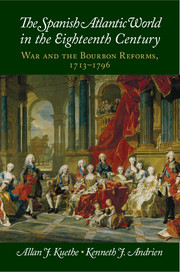Book contents
- Frontmatter
- Contents
- Introduction: War and Reform in Spain and Its Atlantic Empire
- I Alberoni, Patiño, and the Beginnings of Atlantic Reform, 1713–1736
- II The Second Wave of Reform, 1736–1763
- 4 War and Reform, 1736–1749
- 5 Clerical Reform and the Secularization of the Doctrinas de Indios
- 6 The Downfall of Ensenada and the Pause, 1750–1763
- III Pinnacle of the Bourbon Reforms, 1763–1796
- Timeline for the Spanish Atlantic World in the Eighteenth Century
- Bibliography
- Index
- Plate section
- References
4 - War and Reform, 1736–1749
Published online by Cambridge University Press: 05 June 2014
- Frontmatter
- Contents
- Introduction: War and Reform in Spain and Its Atlantic Empire
- I Alberoni, Patiño, and the Beginnings of Atlantic Reform, 1713–1736
- II The Second Wave of Reform, 1736–1763
- 4 War and Reform, 1736–1749
- 5 Clerical Reform and the Secularization of the Doctrinas de Indios
- 6 The Downfall of Ensenada and the Pause, 1750–1763
- III Pinnacle of the Bourbon Reforms, 1763–1796
- Timeline for the Spanish Atlantic World in the Eighteenth Century
- Bibliography
- Index
- Plate section
- References
Summary
Following Patiño’s decade in power, the outbreak of war with Great Britain and new attitudes about imperial reform in Madrid opened the door to fundamental changes in the Spanish Atlantic empire. The customary harmony between royal administration and the Consulado of Cádiz abruptly collapsed, leading to reform initiatives that reduced the privileged position of the Andalusian elite. Most of this tumultuous period found Spain engulfed in the War of Jenkins’ Ear (1739–1748), a dangerous struggle in the American theater where Spanish arms competed successfully with the aggressive and powerful forces of an expansionist British foe. This first war fought exclusively over colonial issues later merged with dynastic conflicts in Europe producing the War of the Austrian Succession (1740–1748). The pressures imposed on the transatlantic trade during this international conflict led the Madrid government to abandon temporarily the traditional system of Flotas and Galeones in favor of using individual register ships, a transformation bearing profound implications for the future.
Strong ministerial leaders pushed forward these important changes, particularly with the emergence of José del Campillo y Cossío, who championed a wide range of reforms, most notably free trade within the empire. Campillo’s ideas about imperial reform marked a major change from the more narrowly pragmatic policies of Alberoni and Patiño, which emphasized gaining control over Spain’s port cities, attacking foreign contraband commerce in the Caribbean, South Atlantic, and Pacific, and reestablishing a strong convoy system in the transatlantic trade. After Campillo’s premature death, power passed to Zenón de Somodevilla, the Marqués de la Ensenada, one of the Bourbon century’s most impressive and successful leaders. During this second era of reform, however, Ensenada would advance well beyond the pragmatism of Alberoni and Patiño, ending the sale of bureaucratic appointments, modernizing state finances, liberalizing trade with South America, and curtailing the power of the church. The death of Philip V in 1746 and the succession of his son, Ferdinand VI, also removed Elizabeth Farnese from the court, and an Atlantic agenda quickly replaced her narrowly focused Italian dynastic priorities, which had so often led to conflict in the past. After the war ended in 1748, a new era of reform and renovation produced profound changes in the Spanish Atlantic world and laid the foundation for many others.
- Type
- Chapter
- Information
- The Spanish Atlantic World in the Eighteenth CenturyWar and the Bourbon Reforms, 1713–1796, pp. 133 - 166Publisher: Cambridge University PressPrint publication year: 2014

